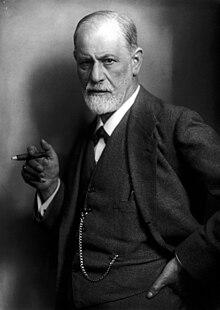Sigmund Freud
Main article: Sigmund Freud's views on homosexuality
Freud (1856–1939) was skeptical of the possibility of therapeutic conversion.
Freud‘s main discussion of female homosexuality was the 1920 paper “The Psychogenesis of a Case of Homosexuality in a Woman“, which described his analysis of a young woman who had entered therapy because her parents were concerned that she was a lesbian. Her father wanted this condition changed. In Freud‘s view, the prognosis was unfavourable because of the circumstances under which she entered therapy, and because homosexuality was not an illness or neurotic conflict. Freud wrote that changing homosexuality was difficult and possible only under unusually favourable conditions, observing that “in general to undertake to convert a fully developed homosexual into a heterosexual does not offer much more prospect of success than the reverse.”[30] Success meant making heterosexual feeling possible, not eliminating homosexual feelings.[31]
Gay people could seldom be convinced that heterosexual sex would provide them with the same pleasure they derived from homosexual sex. Patients often wanted to become heterosexual for reasons Freud considered superficial, including fear of social disapproval, an insufficient motive for change. Some might have no real desire to become heterosexual, seeking treatment only to convince themselves that they had done everything possible to change, leaving them free to return to homosexuality after the failure they expected.[32][33][34]
In 1935, a mother asked Freud to treat her son. Freud replied in a letter that later became famous:[35]
"I gather from your letter that your son is a homosexual. [...] it is nothing to be ashamed of, no vice, no degradation; it cannot be classified as an illness; we consider it to be a variation of the sexual function, produced by a certain arrest of sexual development. [...] By asking me if I can help [your son], you mean, I suppose, if I can abolish homosexuality and make normal heterosexuality take its place. The answer is, in a general way we cannot promise to achieve it. In a certain number of cases we succeed in developing the blighted germs of heterosexual tendencies, which are present in every homosexual; in the majority of cases it is no more possible. It is a question of the quality and the age of the individual. The result of treatment cannot be predicted."[36]


No comments:
Post a Comment